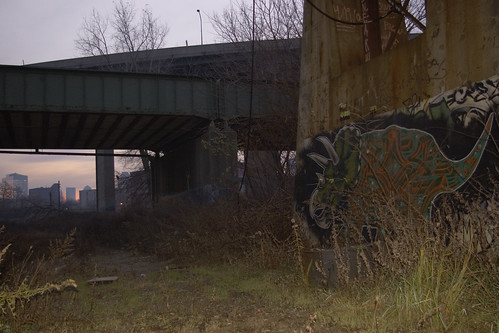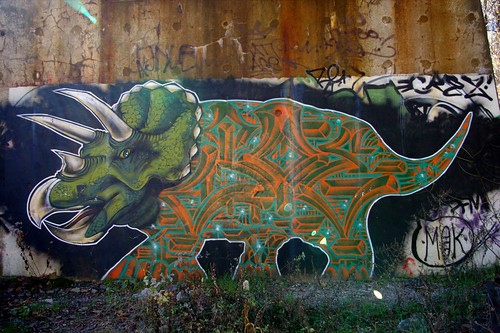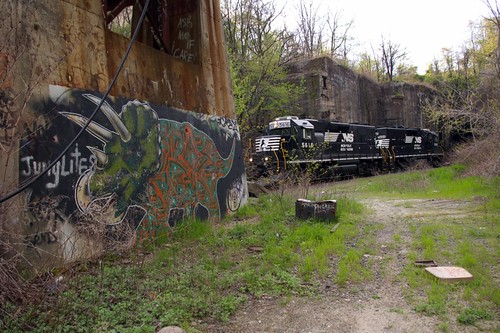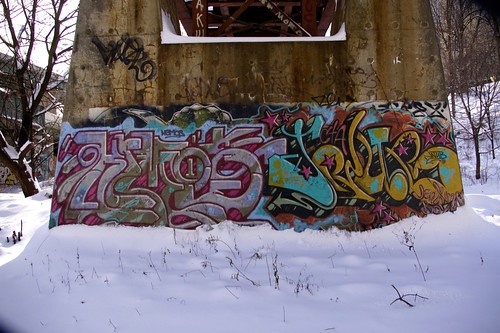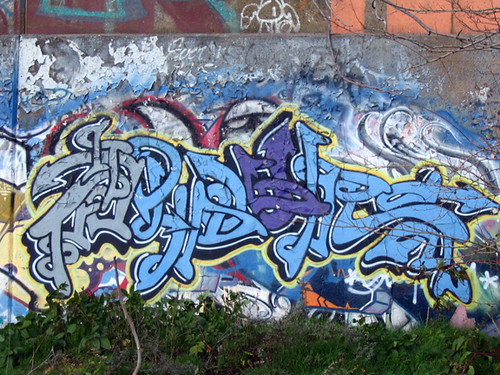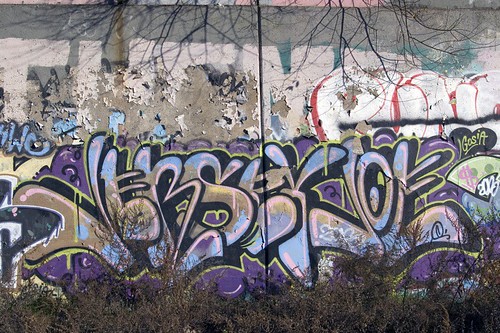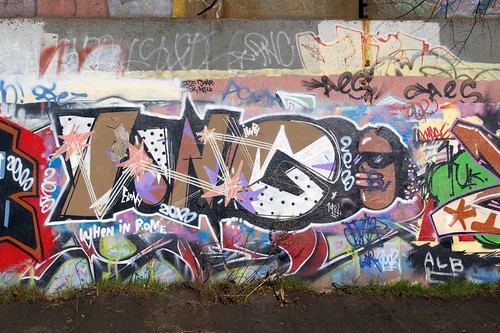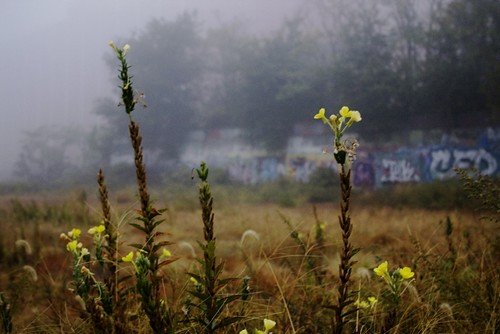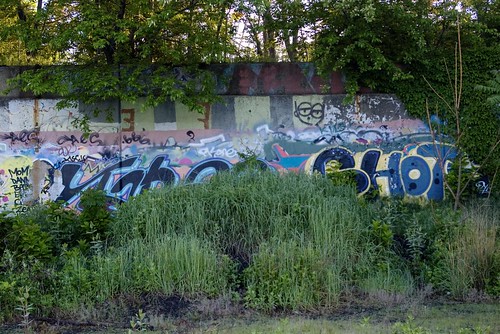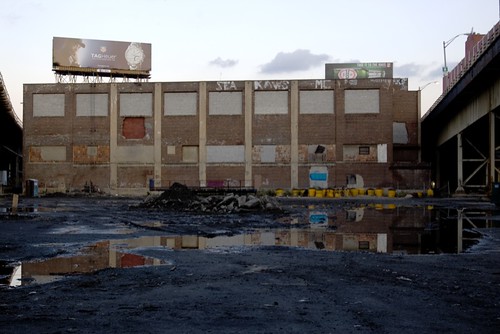by Bill Benzon
Over the past few years I’ve spent a great deal of time photographing graffiti in Jersey City, which is on the West bank of the Hudson River across from lower Manhattan. Most of that time I’ve photographed a handful of sites, over and over again, week after week, month after month. What I’ve seen is that things change. Of course the graffiti is eroded by the weather; in some cases it may also be “buffed” (eradicated) by the authorities. More likely, though, is that it will become over-written by other graffiti writers – that’s what they call themselves, by the way, writers, for their art is grounded in letters.
Even this piece, which looks like a green triceratops, is a name: “Joe”, shortened from “Japan Joe”, the nom de guerre of the writer:
It’s large; about 18 feet wide and seven feet high. Here you see a train going by:
Think of Japan Joe in that spot, working for several hours, surrounded by greenery, but also the large freight trains rumbling by. The trains and the greenery travel into his mind where they fuse into the image of a large green animal, the triceratops.
That’s the spirit of the place.
And, in time, Japan Joe’s triceratops had been degraded by the weather to the point that Kemos and Jnub could go over it without insulting Joe:
Life goes on.
Thus I have come to understand the graffiti site as more than a physical place. It IS that, but the physical place is to be understood, perhaps, provisionally, as a resource accessed by the graffiti, and thus by the graffiti writer. The site is a confluence of physical, social, and aesthetic energy.
From Tokugawa Japan to Jersey City
In order further to understand this, a little comparative investigation is called for. And for that we turn to—where else?—but to Japan and Buddhism. Not directly, but as interpreted through Eiko Ikegami’s wonderful book, Bonds of Civility: Aesthetic Networks and the Political Origins of Japanese Culture (Cambridge 2005). We start with linked verse, a form of collective, public poetry practiced in the 13th century (and later):
The atmosphere of a Cherry Blossom session was intensely moving for its participants. The typical number of seats poets in a za session was not fixed by usually stood at around 10. Unlike the more formal linked-verse meetings of later periods, however, members of the audience that surrounded a circle of poets in a Cherry Blossom session were free to contribute poems of the own to the circle. After one sequence of chain poems was made by seated members in the circle, the floor was open to the public. All the participants in the meeting would avidly search for the best follow-up verse, one after the other, Sometimes, dozens of poems were thrown in from the audience to provide the next stanza in a particularly difficult chain. When an unexpectedly interesting succeeding stanza was presented, the perceptive participants would be captivated by feelings of surprised exhilaration.
In other words, we be jammin’.
Now check this out, it’s from Roger Gastman & Caleb Neelon, The History of American Graffiti (Harper 2010); they’re quoting TDEE, a Jersey City writer talking about the Jersey City Wall of Fame, as it’s sometimes known (p. 276):
All of sudden, already seasoned writers like TECK, SERO, SNOW, and the QMB CREW started rocking ‘our’ walls, to where soon you could go up there on any given Sunday during the summers of 1991 to 1993 and find at least ten people painting, and twenty more just hanging out. . . . The Newport Wall was the first time writers from different New Jersey cities got together on the regular and had a place to meet and paint as a collective.
Times have changed, but the Newport Wall’s still there, only three blocks from the Holland Tunnel and thus within earshot of thousands of cars a day, though it’s been neglected of late and part of the wall’s covered with dirt, dirt thrown there as part of preparations for erecting apartment buildings that have not yet happened.
The Newport Wall
Yoder, now covered with dirt: photo taken in 2006:
Jersey Joe (aka Rime), covered with dirt: photo taken 2006:
Some writers from the UK (see “UK” in the green at the right edge), notice the freshly dozed dirt in front of the wall; photo from December 2006:
Here’s a long shot, from the “North Approach” (ha!); notice the freshly piled dirt; photo from December 2006:
A little graffiti in the mist, photo taken 2007:
Taboo and 41Shots, DYM crew from Brooklyn, May 2011:
That is to say, a graffiti site’s a living thing. Like all living things, it changes.
From Mu’en to Kami
But I digress. Back to Ikegami, Japan, and Buddhism (87):
Closer observation of the operation of the Cherry Blossom sessions reveals the presence of multiple devices for creating spheres of mu’en, or “no relation.” The word mu’en (mu means “absence” in literal English translation; en means “relationship”), originally a Buddhist term, implied the absence of a relationship to worldly constraints.
Now, one more passage (p. 90):
In this sense, it was fitting that the Cherry Blossom linked-verse sessions were organized by such nenbutsu hijiri as Zenna because these monks not only renounced the world, but also frequented funerals and graveyards, the realm of the dead. They were persons who typified mu’en in that their bodies and very existence were sites of no-relation. Mu’en referred to sacred places but also to such spaces as markets, trading posts, bridges, riverbanks, and graveyards. Bridges represented physical connections and geographical boundaries. Graveyards were the realm of the dead, in which the living communicated with their ancestors during funerary rituals. Thus mu’en spaces offered a kind of asylum at places of boundary intersection as spheres for transformation.
These mu’en spaces, these ‘no relation’ spaces, could also be thought of as interstitial. However you think of them, the Newport Wall is like that. Fifty or sixty years ago it was a train station. The ground in front of it carried four train tracks while the wall supported a station. Goods and people moved over those tracks to and from the banks of the Hudson River. When the railroads left Jersey City, the tracks were ripped out, the station dismantled, and the site, which once had been bustling with activity, became deserted, useless, between the cracks, mu’en. And then the graffiti moved in, like a spirit. As a manifestation of spirit. The Japanese word is kami, “the central objects of worship for the Shinto faith” according to the Wikipedia:
Some of the objects or phenomena designated as kami are qualities of growth, fertility, and production; natural phenomena like wind and thunder; natural objects like the sun, mountains, rivers, trees, and rocks; some animals; and ancestral spirits. Included within the designation of ancestral spirits are spirits of the ancestors of the Imperial House of Japan, but also ancestors of noble families as well as the spirits of the ancestors of all people. There are other spirits designated as kami as well. For example, the guardian spirits of the land, occupations, and skills; spirits of Japanese heroes, men of outstanding deeds or virtues, and those who have contributed to civilization, culture and human welfare; those who have died for the state or the community; and the pitiable dead.
Graffiti is a manifestation of the kami of a site. Think of it this way: In a modern and secular Western ontology, a place has many separable aspects. It is a physical site consisting of a certain substance, or collection of substances, having a certain location and a certain form. Plants may grow there, animals feed, or nest, or mate, whatever. Those are other aspects of the site. One might also talk of the light incident upon a site, and the sight lines to and through it – very important for architects and urban planners. Then there are the laws governing use of the site and accessibility of the site. Those last laws are very important for graffiti, for they determine whether or not it is legal for a writer to step foot on the site.
My point is, however, that in a modern Western ontology, these features or aspects are all separate. The site can be analyzed into, reduced to, those aspects. What do we call that thing that is all those put together, inseparable? Provisionally, we can call it a kami, the spirit of the site.
The graffiti writer, then, is attracted to, called to a certain site by the kami. What the writer does is a manifestation of the kami. The flow of graffiti on the site, then, expresses the life of the site’s kami.
Addendum: Mana Museum of Urban Arts
This building, which is not far from the Newport Wall, is the new home of the Mana Museum of Urban Arts, that is, graffiti and street art. Though graffiti has been shown in galleries and museums for over thirty years, it has never had permanent space in a dedicated museum. Founded by Eugene Lemay, Director of Mana Contemporary, the museum’s mission includes:
showcasing contemporary street artists from around the world through rotating interior exhibitions, large-scale exterior murals, and through an artist billboard; documenting and preserving historically significant works with a permanent collection and media center; educational outreach; and fostering creativity and community among artists through workshops, artist studios, and public works.
The collection will be curated by two well-known street artists, Logan Hicks and Joe Iurato, and is scheduled to open this September.
❖ ❖ ❖
Bill Benzon’s blog, New Savanna. Posts about graffiti in general, about graffiti sites; my graffiti photos at Flickr.

